TLI50415 Logistics Diploma: Optimizing Supply Chains & Sustainability
VerifiedAdded on 2022/10/04
|67
|9275
|35
Practical Assignment
AI Summary
This assignment comprises a workplace simulation focusing on supply chain management and sustainability within two distinct business contexts: Sabah Furniture and McDonald's. The Sabah Furniture section involves developing a process map, aligning supply chain strategies with corporate objectives, identifying potential risks, and proposing logistical improvements to meet international retailer requirements. The McDonald's section delves into the company's sustainability initiatives, examining specific actions taken to ensure a sustainable supply chain, analyzing their vision statement, and explaining their approach to environmental responsibility. It further explores the use of sustainability footprint assessment tools and the five pillars of McDonald's sustainability framework, concluding with an analysis of Green Star restaurant categories related to logistics. This comprehensive analysis provides insights into practical applications of supply chain optimization and sustainability practices in diverse organizational settings. Desklib offers a wealth of resources, including solved assignments and past papers, to aid students in their studies.
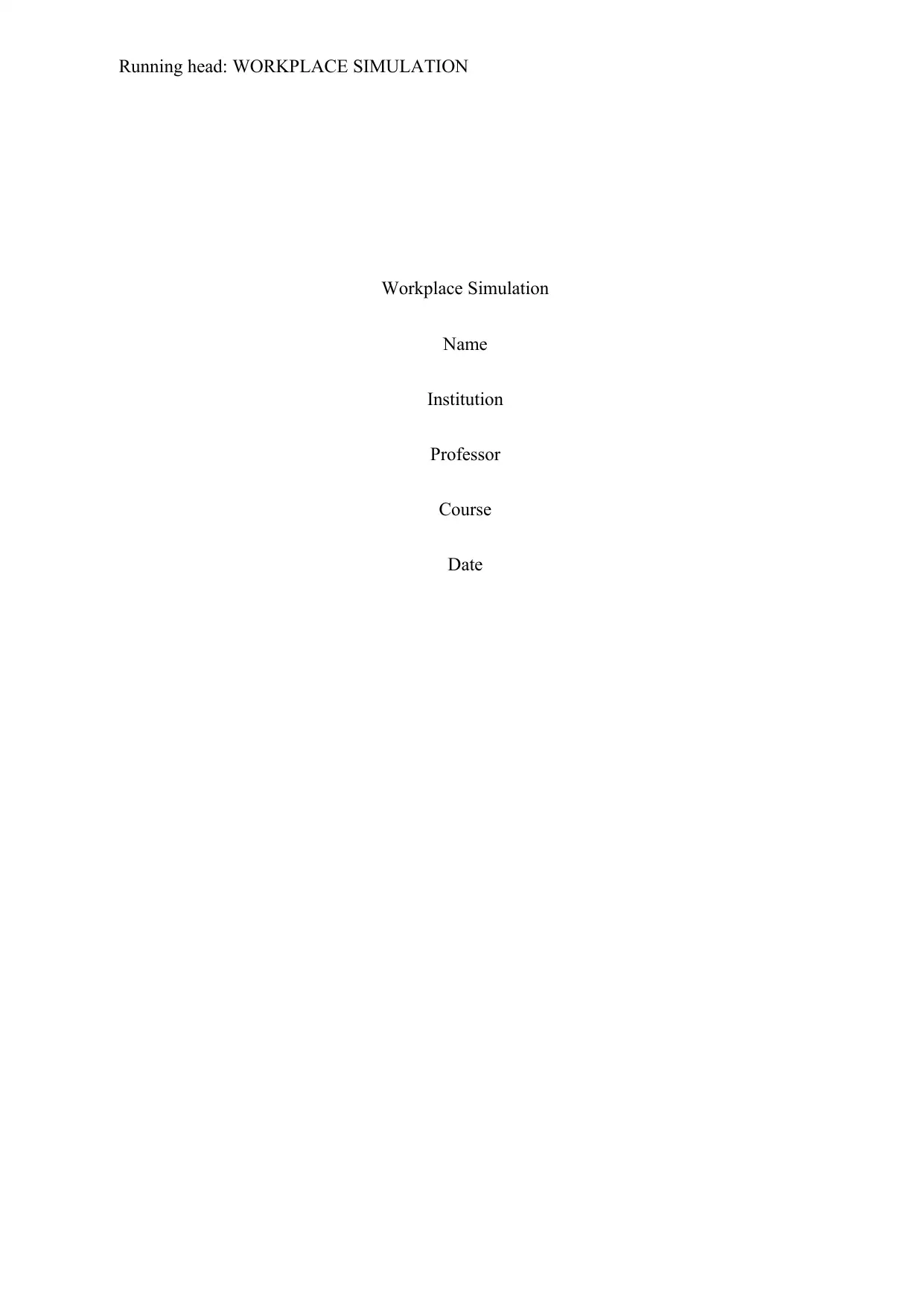
Running head: WORKPLACE SIMULATION
Workplace Simulation
Name
Institution
Professor
Course
Date
Workplace Simulation
Name
Institution
Professor
Course
Date
Paraphrase This Document
Need a fresh take? Get an instant paraphrase of this document with our AI Paraphraser
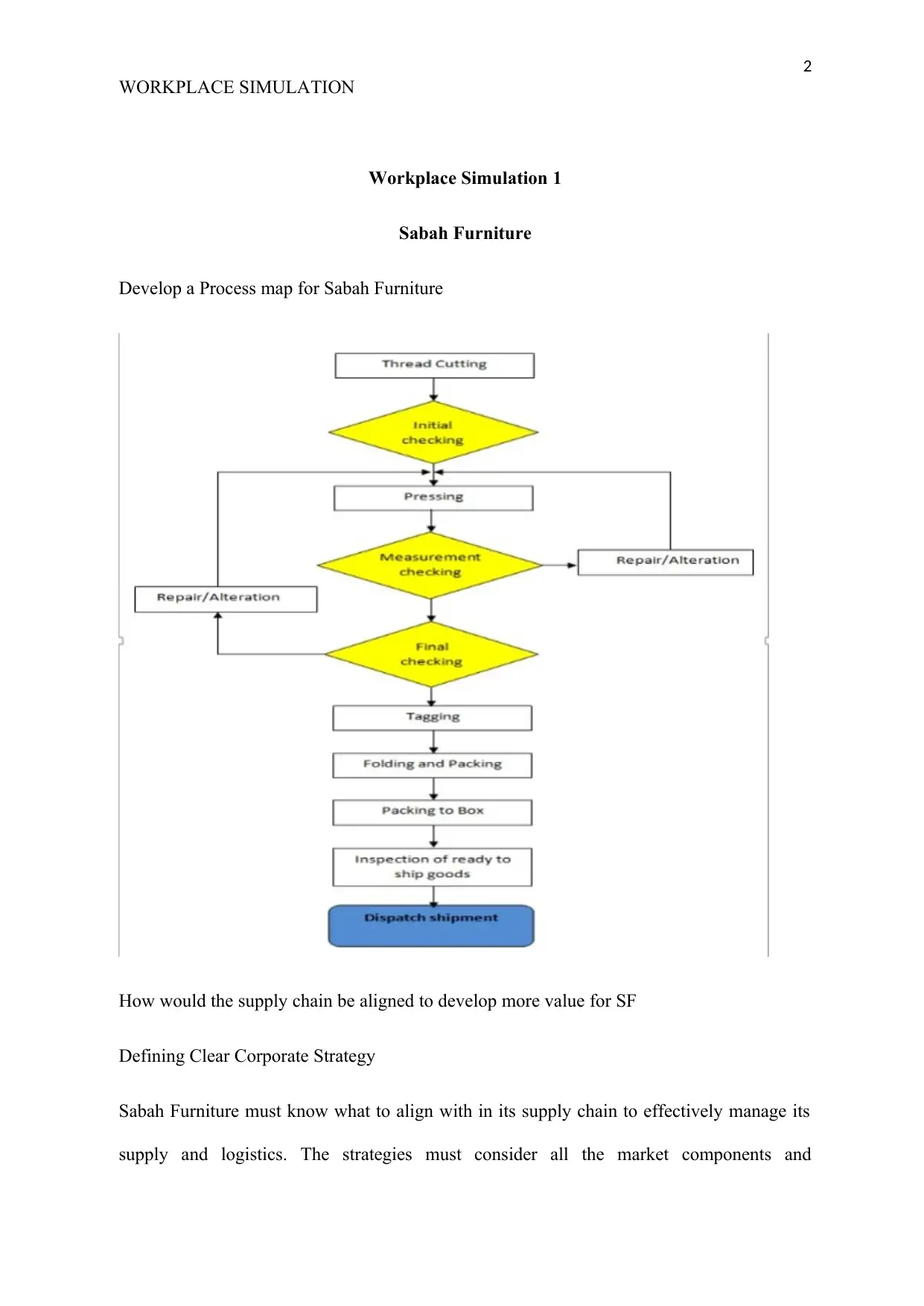
2
WORKPLACE SIMULATION
Workplace Simulation 1
Sabah Furniture
Develop a Process map for Sabah Furniture
How would the supply chain be aligned to develop more value for SF
Defining Clear Corporate Strategy
Sabah Furniture must know what to align with in its supply chain to effectively manage its
supply and logistics. The strategies must consider all the market components and
WORKPLACE SIMULATION
Workplace Simulation 1
Sabah Furniture
Develop a Process map for Sabah Furniture
How would the supply chain be aligned to develop more value for SF
Defining Clear Corporate Strategy
Sabah Furniture must know what to align with in its supply chain to effectively manage its
supply and logistics. The strategies must consider all the market components and
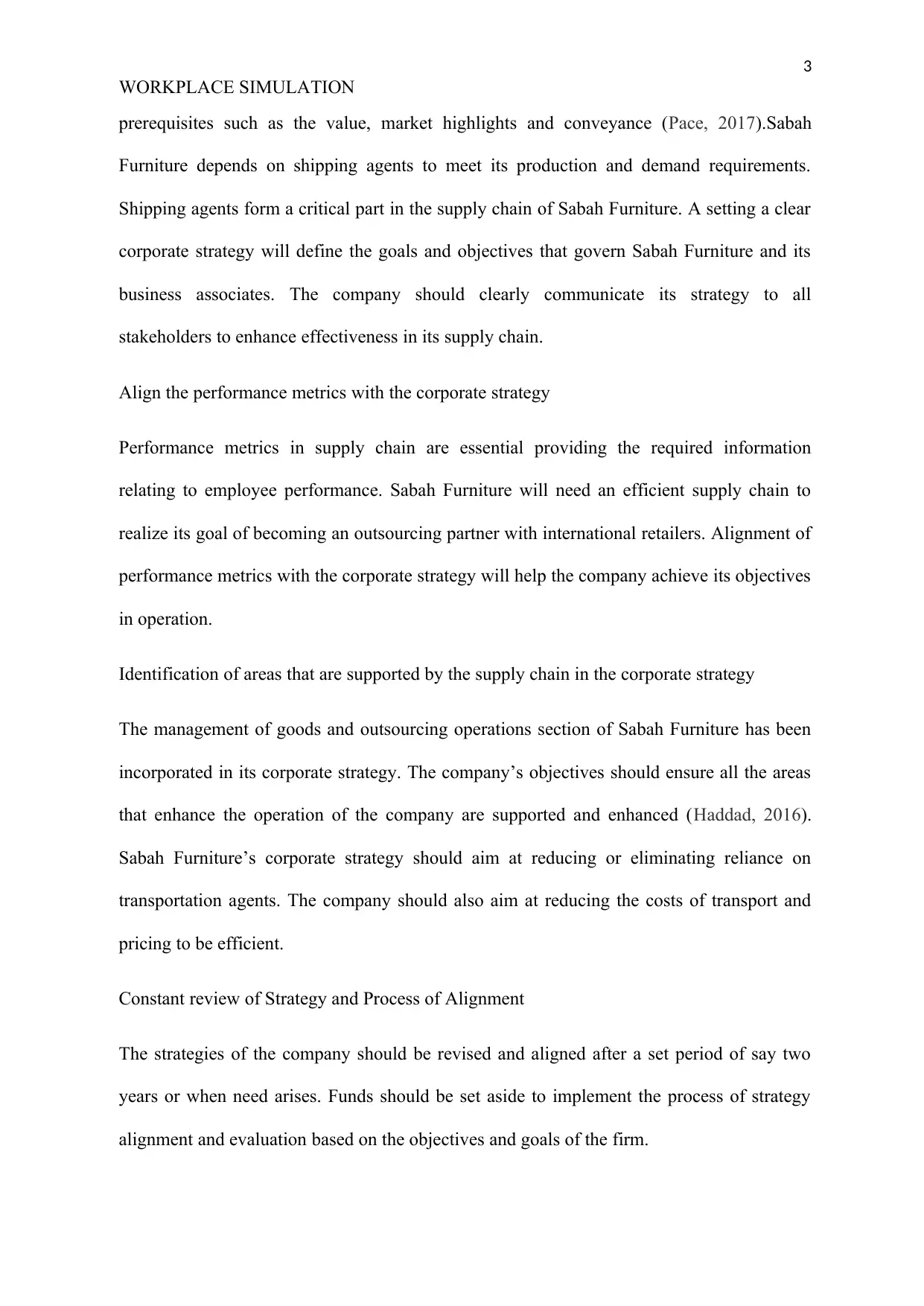
3
WORKPLACE SIMULATION
prerequisites such as the value, market highlights and conveyance (Pace, 2017).Sabah
Furniture depends on shipping agents to meet its production and demand requirements.
Shipping agents form a critical part in the supply chain of Sabah Furniture. A setting a clear
corporate strategy will define the goals and objectives that govern Sabah Furniture and its
business associates. The company should clearly communicate its strategy to all
stakeholders to enhance effectiveness in its supply chain.
Align the performance metrics with the corporate strategy
Performance metrics in supply chain are essential providing the required information
relating to employee performance. Sabah Furniture will need an efficient supply chain to
realize its goal of becoming an outsourcing partner with international retailers. Alignment of
performance metrics with the corporate strategy will help the company achieve its objectives
in operation.
Identification of areas that are supported by the supply chain in the corporate strategy
The management of goods and outsourcing operations section of Sabah Furniture has been
incorporated in its corporate strategy. The company’s objectives should ensure all the areas
that enhance the operation of the company are supported and enhanced (Haddad, 2016).
Sabah Furniture’s corporate strategy should aim at reducing or eliminating reliance on
transportation agents. The company should also aim at reducing the costs of transport and
pricing to be efficient.
Constant review of Strategy and Process of Alignment
The strategies of the company should be revised and aligned after a set period of say two
years or when need arises. Funds should be set aside to implement the process of strategy
alignment and evaluation based on the objectives and goals of the firm.
WORKPLACE SIMULATION
prerequisites such as the value, market highlights and conveyance (Pace, 2017).Sabah
Furniture depends on shipping agents to meet its production and demand requirements.
Shipping agents form a critical part in the supply chain of Sabah Furniture. A setting a clear
corporate strategy will define the goals and objectives that govern Sabah Furniture and its
business associates. The company should clearly communicate its strategy to all
stakeholders to enhance effectiveness in its supply chain.
Align the performance metrics with the corporate strategy
Performance metrics in supply chain are essential providing the required information
relating to employee performance. Sabah Furniture will need an efficient supply chain to
realize its goal of becoming an outsourcing partner with international retailers. Alignment of
performance metrics with the corporate strategy will help the company achieve its objectives
in operation.
Identification of areas that are supported by the supply chain in the corporate strategy
The management of goods and outsourcing operations section of Sabah Furniture has been
incorporated in its corporate strategy. The company’s objectives should ensure all the areas
that enhance the operation of the company are supported and enhanced (Haddad, 2016).
Sabah Furniture’s corporate strategy should aim at reducing or eliminating reliance on
transportation agents. The company should also aim at reducing the costs of transport and
pricing to be efficient.
Constant review of Strategy and Process of Alignment
The strategies of the company should be revised and aligned after a set period of say two
years or when need arises. Funds should be set aside to implement the process of strategy
alignment and evaluation based on the objectives and goals of the firm.
⊘ This is a preview!⊘
Do you want full access?
Subscribe today to unlock all pages.

Trusted by 1+ million students worldwide
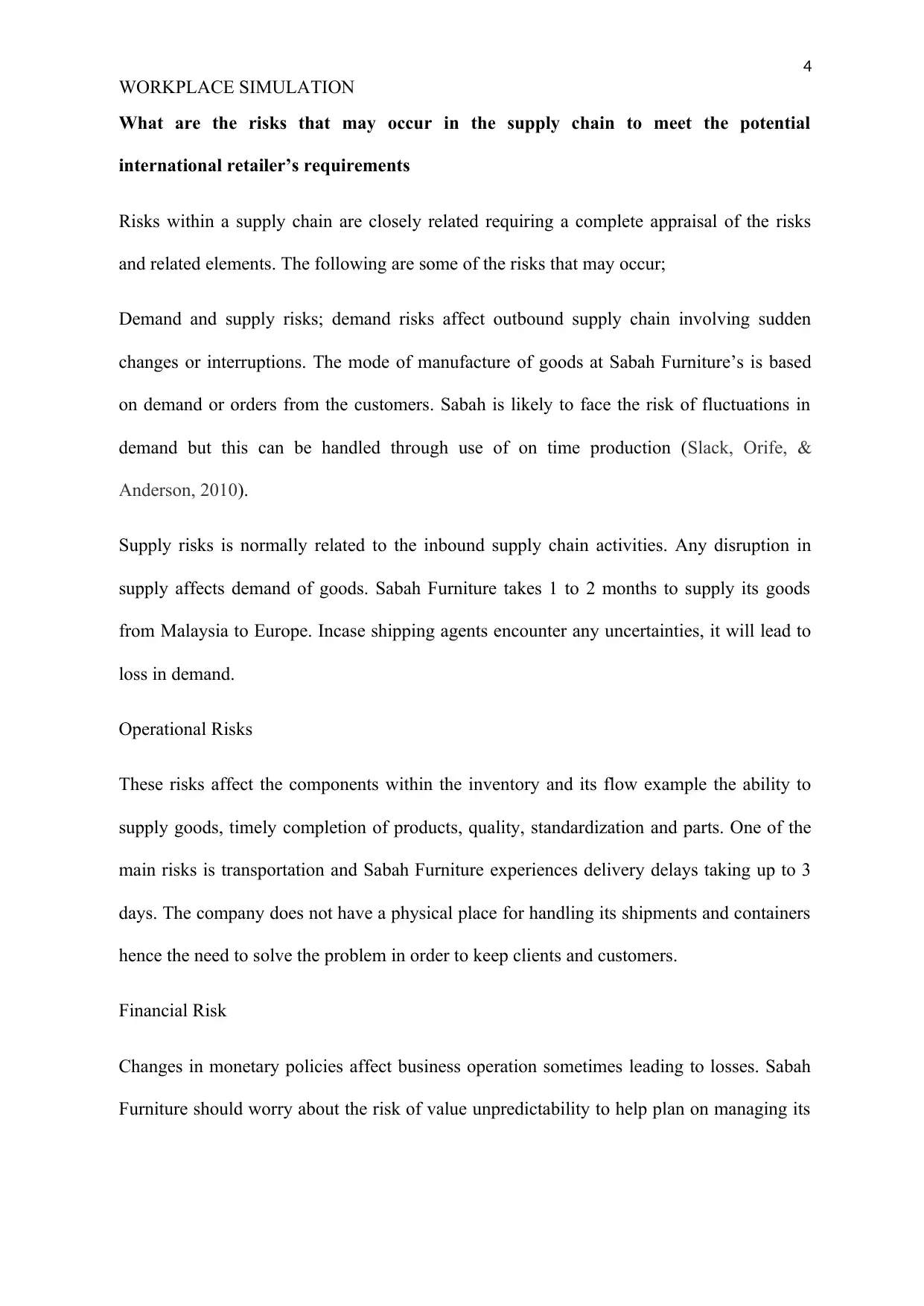
4
WORKPLACE SIMULATION
What are the risks that may occur in the supply chain to meet the potential
international retailer’s requirements
Risks within a supply chain are closely related requiring a complete appraisal of the risks
and related elements. The following are some of the risks that may occur;
Demand and supply risks; demand risks affect outbound supply chain involving sudden
changes or interruptions. The mode of manufacture of goods at Sabah Furniture’s is based
on demand or orders from the customers. Sabah is likely to face the risk of fluctuations in
demand but this can be handled through use of on time production (Slack, Orife, &
Anderson, 2010).
Supply risks is normally related to the inbound supply chain activities. Any disruption in
supply affects demand of goods. Sabah Furniture takes 1 to 2 months to supply its goods
from Malaysia to Europe. Incase shipping agents encounter any uncertainties, it will lead to
loss in demand.
Operational Risks
These risks affect the components within the inventory and its flow example the ability to
supply goods, timely completion of products, quality, standardization and parts. One of the
main risks is transportation and Sabah Furniture experiences delivery delays taking up to 3
days. The company does not have a physical place for handling its shipments and containers
hence the need to solve the problem in order to keep clients and customers.
Financial Risk
Changes in monetary policies affect business operation sometimes leading to losses. Sabah
Furniture should worry about the risk of value unpredictability to help plan on managing its
WORKPLACE SIMULATION
What are the risks that may occur in the supply chain to meet the potential
international retailer’s requirements
Risks within a supply chain are closely related requiring a complete appraisal of the risks
and related elements. The following are some of the risks that may occur;
Demand and supply risks; demand risks affect outbound supply chain involving sudden
changes or interruptions. The mode of manufacture of goods at Sabah Furniture’s is based
on demand or orders from the customers. Sabah is likely to face the risk of fluctuations in
demand but this can be handled through use of on time production (Slack, Orife, &
Anderson, 2010).
Supply risks is normally related to the inbound supply chain activities. Any disruption in
supply affects demand of goods. Sabah Furniture takes 1 to 2 months to supply its goods
from Malaysia to Europe. Incase shipping agents encounter any uncertainties, it will lead to
loss in demand.
Operational Risks
These risks affect the components within the inventory and its flow example the ability to
supply goods, timely completion of products, quality, standardization and parts. One of the
main risks is transportation and Sabah Furniture experiences delivery delays taking up to 3
days. The company does not have a physical place for handling its shipments and containers
hence the need to solve the problem in order to keep clients and customers.
Financial Risk
Changes in monetary policies affect business operation sometimes leading to losses. Sabah
Furniture should worry about the risk of value unpredictability to help plan on managing its
Paraphrase This Document
Need a fresh take? Get an instant paraphrase of this document with our AI Paraphraser
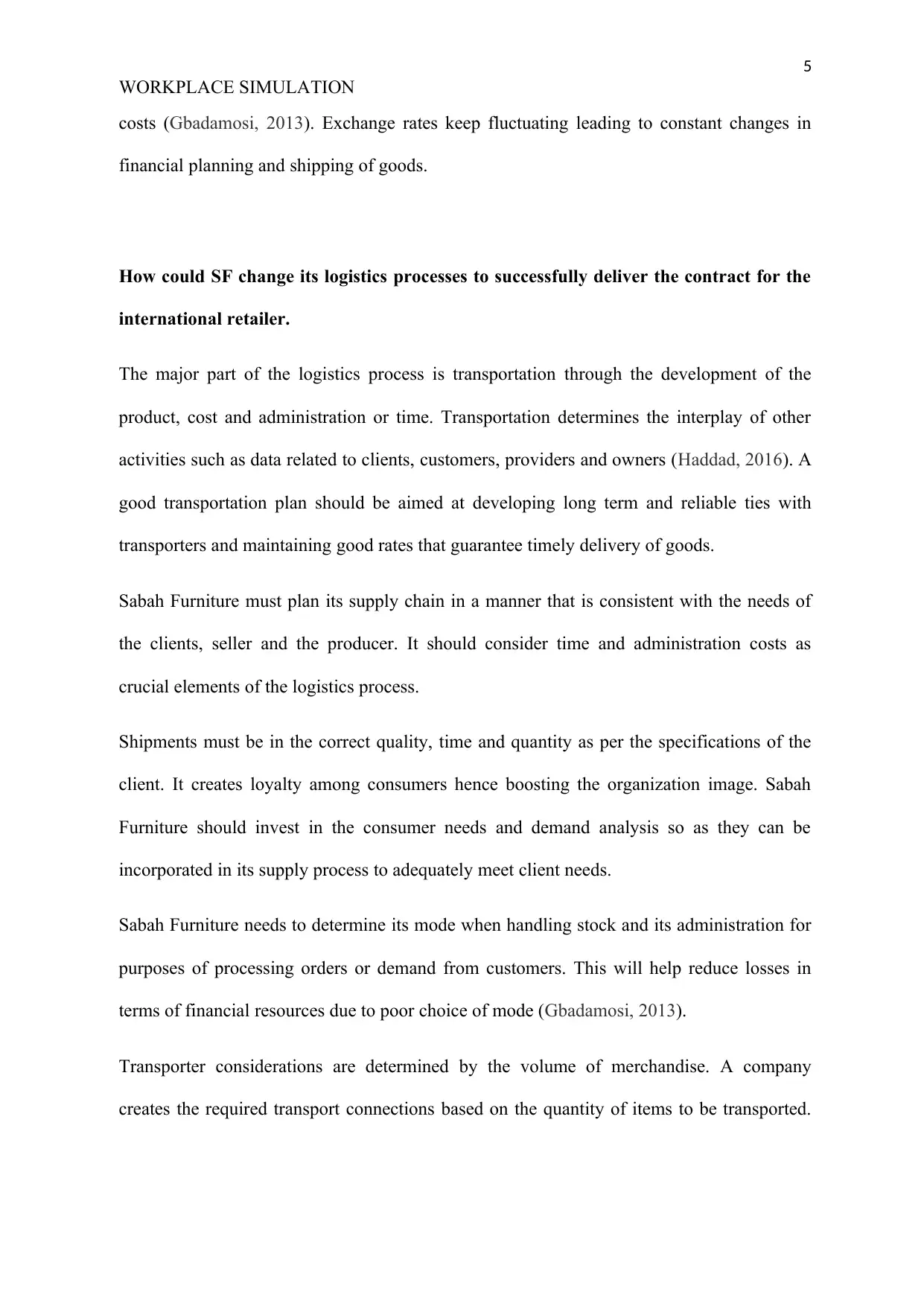
5
WORKPLACE SIMULATION
costs (Gbadamosi, 2013). Exchange rates keep fluctuating leading to constant changes in
financial planning and shipping of goods.
How could SF change its logistics processes to successfully deliver the contract for the
international retailer.
The major part of the logistics process is transportation through the development of the
product, cost and administration or time. Transportation determines the interplay of other
activities such as data related to clients, customers, providers and owners (Haddad, 2016). A
good transportation plan should be aimed at developing long term and reliable ties with
transporters and maintaining good rates that guarantee timely delivery of goods.
Sabah Furniture must plan its supply chain in a manner that is consistent with the needs of
the clients, seller and the producer. It should consider time and administration costs as
crucial elements of the logistics process.
Shipments must be in the correct quality, time and quantity as per the specifications of the
client. It creates loyalty among consumers hence boosting the organization image. Sabah
Furniture should invest in the consumer needs and demand analysis so as they can be
incorporated in its supply process to adequately meet client needs.
Sabah Furniture needs to determine its mode when handling stock and its administration for
purposes of processing orders or demand from customers. This will help reduce losses in
terms of financial resources due to poor choice of mode (Gbadamosi, 2013).
Transporter considerations are determined by the volume of merchandise. A company
creates the required transport connections based on the quantity of items to be transported.
WORKPLACE SIMULATION
costs (Gbadamosi, 2013). Exchange rates keep fluctuating leading to constant changes in
financial planning and shipping of goods.
How could SF change its logistics processes to successfully deliver the contract for the
international retailer.
The major part of the logistics process is transportation through the development of the
product, cost and administration or time. Transportation determines the interplay of other
activities such as data related to clients, customers, providers and owners (Haddad, 2016). A
good transportation plan should be aimed at developing long term and reliable ties with
transporters and maintaining good rates that guarantee timely delivery of goods.
Sabah Furniture must plan its supply chain in a manner that is consistent with the needs of
the clients, seller and the producer. It should consider time and administration costs as
crucial elements of the logistics process.
Shipments must be in the correct quality, time and quantity as per the specifications of the
client. It creates loyalty among consumers hence boosting the organization image. Sabah
Furniture should invest in the consumer needs and demand analysis so as they can be
incorporated in its supply process to adequately meet client needs.
Sabah Furniture needs to determine its mode when handling stock and its administration for
purposes of processing orders or demand from customers. This will help reduce losses in
terms of financial resources due to poor choice of mode (Gbadamosi, 2013).
Transporter considerations are determined by the volume of merchandise. A company
creates the required transport connections based on the quantity of items to be transported.
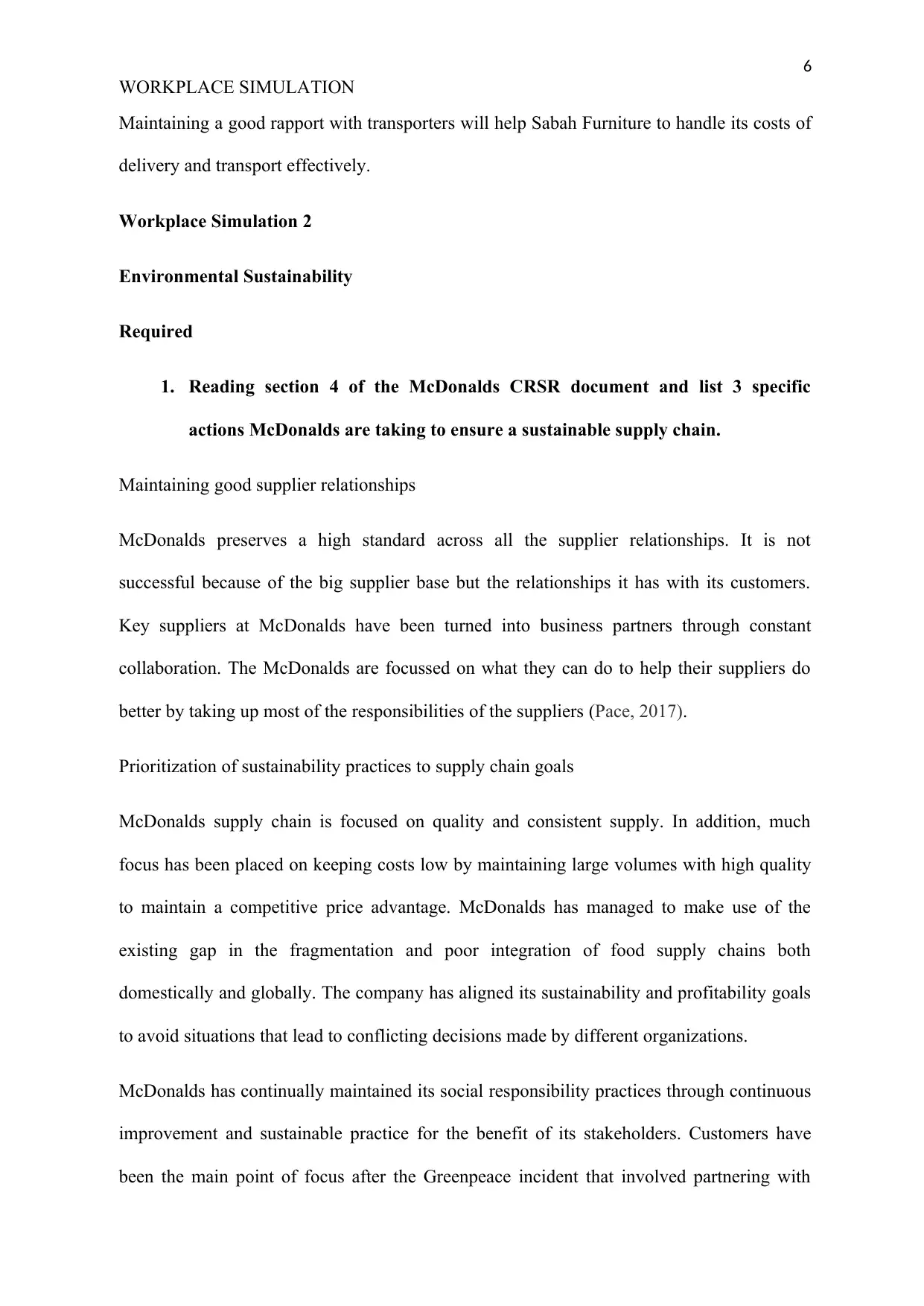
6
WORKPLACE SIMULATION
Maintaining a good rapport with transporters will help Sabah Furniture to handle its costs of
delivery and transport effectively.
Workplace Simulation 2
Environmental Sustainability
Required
1. Reading section 4 of the McDonalds CRSR document and list 3 specific
actions McDonalds are taking to ensure a sustainable supply chain.
Maintaining good supplier relationships
McDonalds preserves a high standard across all the supplier relationships. It is not
successful because of the big supplier base but the relationships it has with its customers.
Key suppliers at McDonalds have been turned into business partners through constant
collaboration. The McDonalds are focussed on what they can do to help their suppliers do
better by taking up most of the responsibilities of the suppliers (Pace, 2017).
Prioritization of sustainability practices to supply chain goals
McDonalds supply chain is focused on quality and consistent supply. In addition, much
focus has been placed on keeping costs low by maintaining large volumes with high quality
to maintain a competitive price advantage. McDonalds has managed to make use of the
existing gap in the fragmentation and poor integration of food supply chains both
domestically and globally. The company has aligned its sustainability and profitability goals
to avoid situations that lead to conflicting decisions made by different organizations.
McDonalds has continually maintained its social responsibility practices through continuous
improvement and sustainable practice for the benefit of its stakeholders. Customers have
been the main point of focus after the Greenpeace incident that involved partnering with
WORKPLACE SIMULATION
Maintaining a good rapport with transporters will help Sabah Furniture to handle its costs of
delivery and transport effectively.
Workplace Simulation 2
Environmental Sustainability
Required
1. Reading section 4 of the McDonalds CRSR document and list 3 specific
actions McDonalds are taking to ensure a sustainable supply chain.
Maintaining good supplier relationships
McDonalds preserves a high standard across all the supplier relationships. It is not
successful because of the big supplier base but the relationships it has with its customers.
Key suppliers at McDonalds have been turned into business partners through constant
collaboration. The McDonalds are focussed on what they can do to help their suppliers do
better by taking up most of the responsibilities of the suppliers (Pace, 2017).
Prioritization of sustainability practices to supply chain goals
McDonalds supply chain is focused on quality and consistent supply. In addition, much
focus has been placed on keeping costs low by maintaining large volumes with high quality
to maintain a competitive price advantage. McDonalds has managed to make use of the
existing gap in the fragmentation and poor integration of food supply chains both
domestically and globally. The company has aligned its sustainability and profitability goals
to avoid situations that lead to conflicting decisions made by different organizations.
McDonalds has continually maintained its social responsibility practices through continuous
improvement and sustainable practice for the benefit of its stakeholders. Customers have
been the main point of focus after the Greenpeace incident that involved partnering with
⊘ This is a preview!⊘
Do you want full access?
Subscribe today to unlock all pages.

Trusted by 1+ million students worldwide
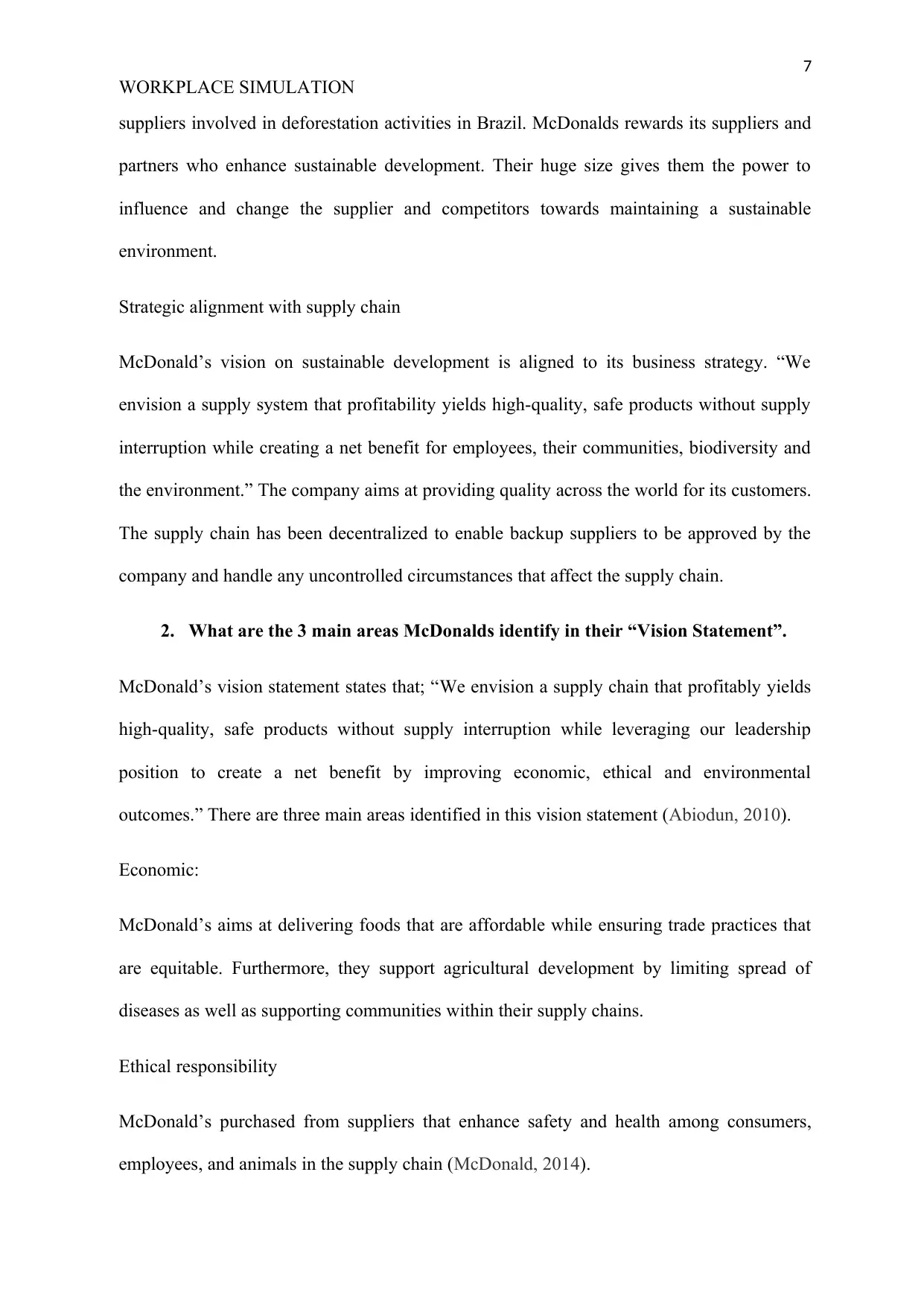
7
WORKPLACE SIMULATION
suppliers involved in deforestation activities in Brazil. McDonalds rewards its suppliers and
partners who enhance sustainable development. Their huge size gives them the power to
influence and change the supplier and competitors towards maintaining a sustainable
environment.
Strategic alignment with supply chain
McDonald’s vision on sustainable development is aligned to its business strategy. “We
envision a supply system that profitability yields high-quality, safe products without supply
interruption while creating a net benefit for employees, their communities, biodiversity and
the environment.” The company aims at providing quality across the world for its customers.
The supply chain has been decentralized to enable backup suppliers to be approved by the
company and handle any uncontrolled circumstances that affect the supply chain.
2. What are the 3 main areas McDonalds identify in their “Vision Statement”.
McDonald’s vision statement states that; “We envision a supply chain that profitably yields
high-quality, safe products without supply interruption while leveraging our leadership
position to create a net benefit by improving economic, ethical and environmental
outcomes.” There are three main areas identified in this vision statement (Abiodun, 2010).
Economic:
McDonald’s aims at delivering foods that are affordable while ensuring trade practices that
are equitable. Furthermore, they support agricultural development by limiting spread of
diseases as well as supporting communities within their supply chains.
Ethical responsibility
McDonald’s purchased from suppliers that enhance safety and health among consumers,
employees, and animals in the supply chain (McDonald, 2014).
WORKPLACE SIMULATION
suppliers involved in deforestation activities in Brazil. McDonalds rewards its suppliers and
partners who enhance sustainable development. Their huge size gives them the power to
influence and change the supplier and competitors towards maintaining a sustainable
environment.
Strategic alignment with supply chain
McDonald’s vision on sustainable development is aligned to its business strategy. “We
envision a supply system that profitability yields high-quality, safe products without supply
interruption while creating a net benefit for employees, their communities, biodiversity and
the environment.” The company aims at providing quality across the world for its customers.
The supply chain has been decentralized to enable backup suppliers to be approved by the
company and handle any uncontrolled circumstances that affect the supply chain.
2. What are the 3 main areas McDonalds identify in their “Vision Statement”.
McDonald’s vision statement states that; “We envision a supply chain that profitably yields
high-quality, safe products without supply interruption while leveraging our leadership
position to create a net benefit by improving economic, ethical and environmental
outcomes.” There are three main areas identified in this vision statement (Abiodun, 2010).
Economic:
McDonald’s aims at delivering foods that are affordable while ensuring trade practices that
are equitable. Furthermore, they support agricultural development by limiting spread of
diseases as well as supporting communities within their supply chains.
Ethical responsibility
McDonald’s purchased from suppliers that enhance safety and health among consumers,
employees, and animals in the supply chain (McDonald, 2014).
Paraphrase This Document
Need a fresh take? Get an instant paraphrase of this document with our AI Paraphraser
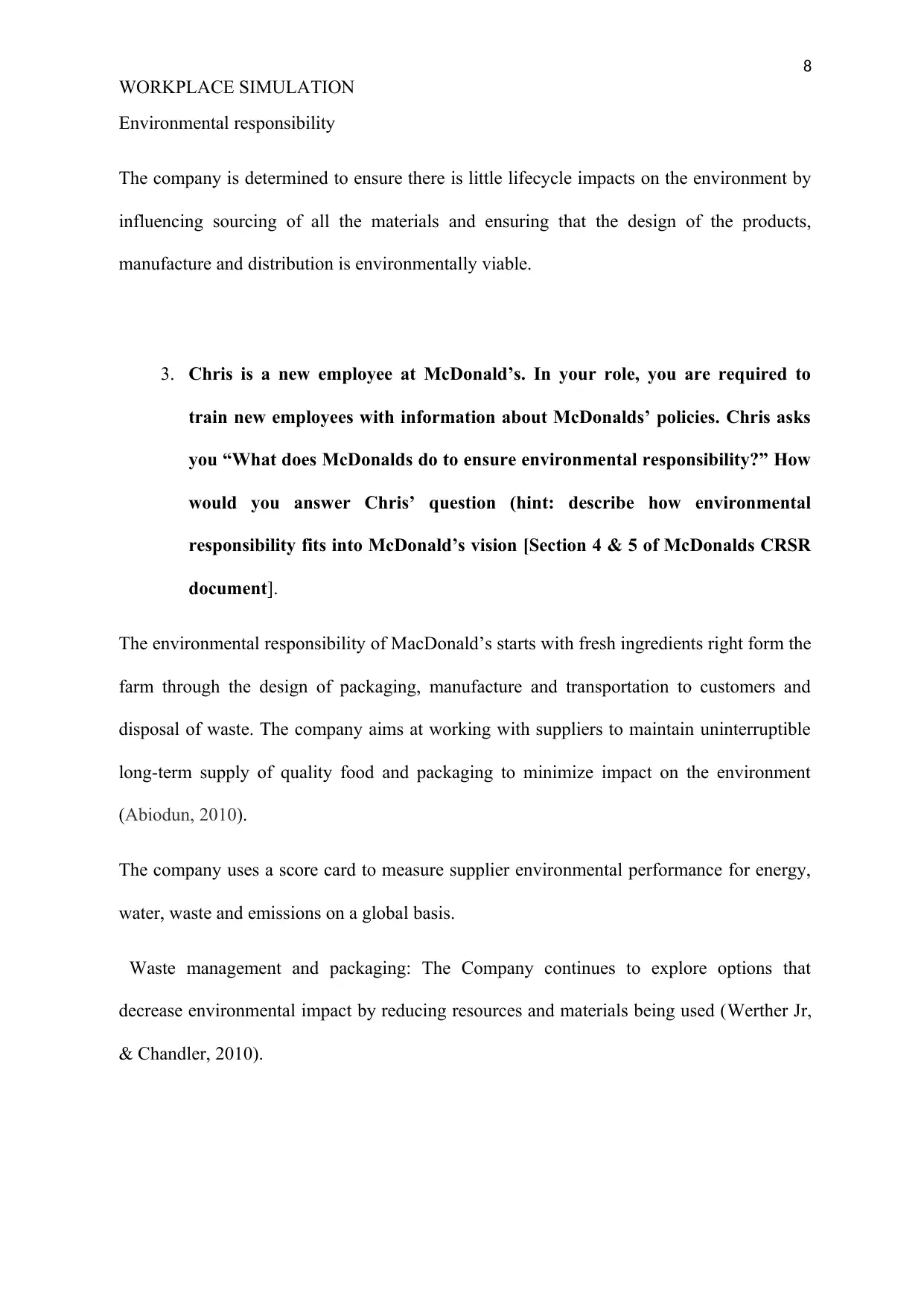
8
WORKPLACE SIMULATION
Environmental responsibility
The company is determined to ensure there is little lifecycle impacts on the environment by
influencing sourcing of all the materials and ensuring that the design of the products,
manufacture and distribution is environmentally viable.
3. Chris is a new employee at McDonald’s. In your role, you are required to
train new employees with information about McDonalds’ policies. Chris asks
you “What does McDonalds do to ensure environmental responsibility?” How
would you answer Chris’ question (hint: describe how environmental
responsibility fits into McDonald’s vision [Section 4 & 5 of McDonalds CRSR
document].
The environmental responsibility of MacDonald’s starts with fresh ingredients right form the
farm through the design of packaging, manufacture and transportation to customers and
disposal of waste. The company aims at working with suppliers to maintain uninterruptible
long-term supply of quality food and packaging to minimize impact on the environment
(Abiodun, 2010).
The company uses a score card to measure supplier environmental performance for energy,
water, waste and emissions on a global basis.
Waste management and packaging: The Company continues to explore options that
decrease environmental impact by reducing resources and materials being used (Werther Jr,
& Chandler, 2010).
WORKPLACE SIMULATION
Environmental responsibility
The company is determined to ensure there is little lifecycle impacts on the environment by
influencing sourcing of all the materials and ensuring that the design of the products,
manufacture and distribution is environmentally viable.
3. Chris is a new employee at McDonald’s. In your role, you are required to
train new employees with information about McDonalds’ policies. Chris asks
you “What does McDonalds do to ensure environmental responsibility?” How
would you answer Chris’ question (hint: describe how environmental
responsibility fits into McDonald’s vision [Section 4 & 5 of McDonalds CRSR
document].
The environmental responsibility of MacDonald’s starts with fresh ingredients right form the
farm through the design of packaging, manufacture and transportation to customers and
disposal of waste. The company aims at working with suppliers to maintain uninterruptible
long-term supply of quality food and packaging to minimize impact on the environment
(Abiodun, 2010).
The company uses a score card to measure supplier environmental performance for energy,
water, waste and emissions on a global basis.
Waste management and packaging: The Company continues to explore options that
decrease environmental impact by reducing resources and materials being used (Werther Jr,
& Chandler, 2010).
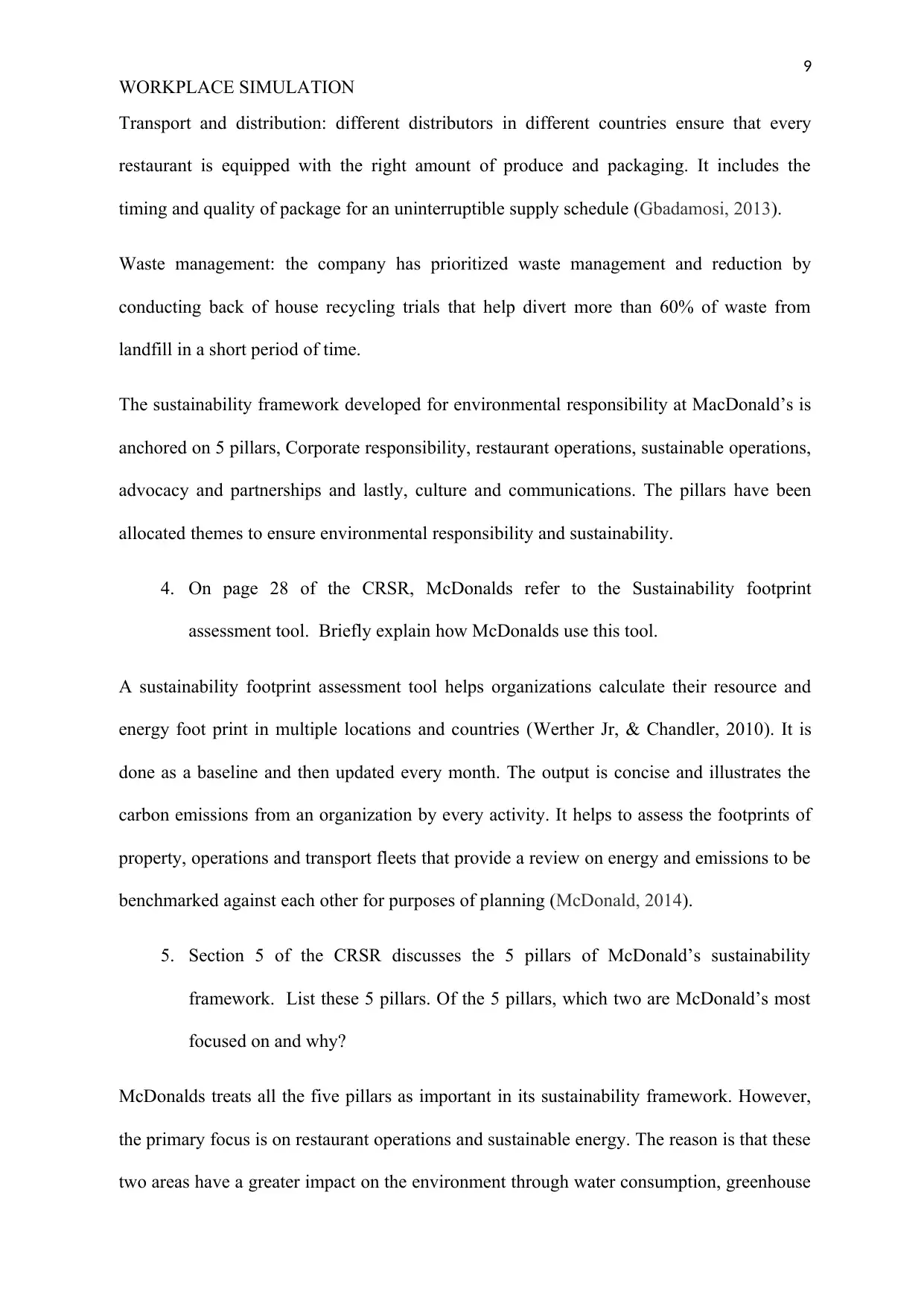
9
WORKPLACE SIMULATION
Transport and distribution: different distributors in different countries ensure that every
restaurant is equipped with the right amount of produce and packaging. It includes the
timing and quality of package for an uninterruptible supply schedule (Gbadamosi, 2013).
Waste management: the company has prioritized waste management and reduction by
conducting back of house recycling trials that help divert more than 60% of waste from
landfill in a short period of time.
The sustainability framework developed for environmental responsibility at MacDonald’s is
anchored on 5 pillars, Corporate responsibility, restaurant operations, sustainable operations,
advocacy and partnerships and lastly, culture and communications. The pillars have been
allocated themes to ensure environmental responsibility and sustainability.
4. On page 28 of the CRSR, McDonalds refer to the Sustainability footprint
assessment tool. Briefly explain how McDonalds use this tool.
A sustainability footprint assessment tool helps organizations calculate their resource and
energy foot print in multiple locations and countries (Werther Jr, & Chandler, 2010). It is
done as a baseline and then updated every month. The output is concise and illustrates the
carbon emissions from an organization by every activity. It helps to assess the footprints of
property, operations and transport fleets that provide a review on energy and emissions to be
benchmarked against each other for purposes of planning (McDonald, 2014).
5. Section 5 of the CRSR discusses the 5 pillars of McDonald’s sustainability
framework. List these 5 pillars. Of the 5 pillars, which two are McDonald’s most
focused on and why?
McDonalds treats all the five pillars as important in its sustainability framework. However,
the primary focus is on restaurant operations and sustainable energy. The reason is that these
two areas have a greater impact on the environment through water consumption, greenhouse
WORKPLACE SIMULATION
Transport and distribution: different distributors in different countries ensure that every
restaurant is equipped with the right amount of produce and packaging. It includes the
timing and quality of package for an uninterruptible supply schedule (Gbadamosi, 2013).
Waste management: the company has prioritized waste management and reduction by
conducting back of house recycling trials that help divert more than 60% of waste from
landfill in a short period of time.
The sustainability framework developed for environmental responsibility at MacDonald’s is
anchored on 5 pillars, Corporate responsibility, restaurant operations, sustainable operations,
advocacy and partnerships and lastly, culture and communications. The pillars have been
allocated themes to ensure environmental responsibility and sustainability.
4. On page 28 of the CRSR, McDonalds refer to the Sustainability footprint
assessment tool. Briefly explain how McDonalds use this tool.
A sustainability footprint assessment tool helps organizations calculate their resource and
energy foot print in multiple locations and countries (Werther Jr, & Chandler, 2010). It is
done as a baseline and then updated every month. The output is concise and illustrates the
carbon emissions from an organization by every activity. It helps to assess the footprints of
property, operations and transport fleets that provide a review on energy and emissions to be
benchmarked against each other for purposes of planning (McDonald, 2014).
5. Section 5 of the CRSR discusses the 5 pillars of McDonald’s sustainability
framework. List these 5 pillars. Of the 5 pillars, which two are McDonald’s most
focused on and why?
McDonalds treats all the five pillars as important in its sustainability framework. However,
the primary focus is on restaurant operations and sustainable energy. The reason is that these
two areas have a greater impact on the environment through water consumption, greenhouse
⊘ This is a preview!⊘
Do you want full access?
Subscribe today to unlock all pages.

Trusted by 1+ million students worldwide
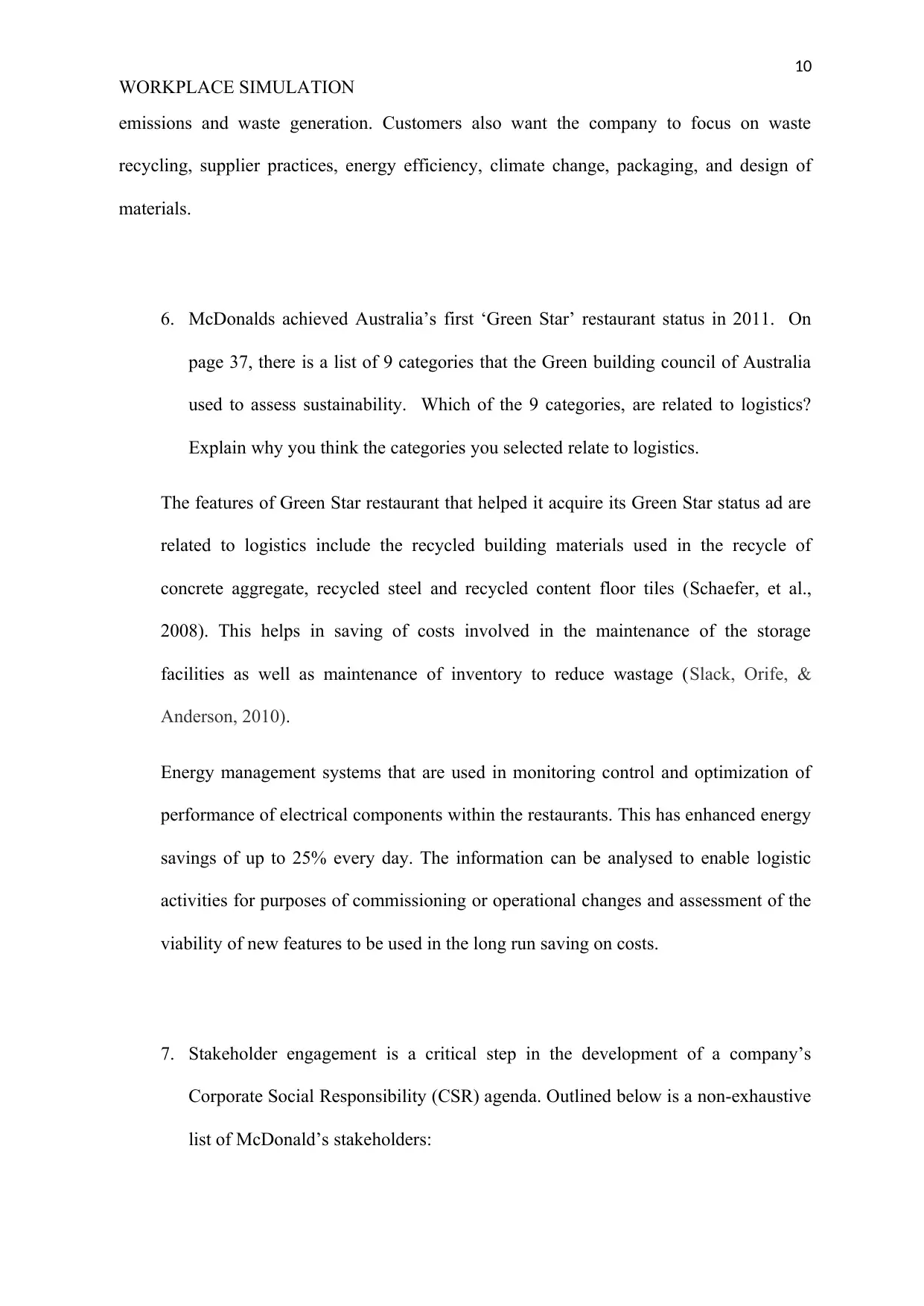
10
WORKPLACE SIMULATION
emissions and waste generation. Customers also want the company to focus on waste
recycling, supplier practices, energy efficiency, climate change, packaging, and design of
materials.
6. McDonalds achieved Australia’s first ‘Green Star’ restaurant status in 2011. On
page 37, there is a list of 9 categories that the Green building council of Australia
used to assess sustainability. Which of the 9 categories, are related to logistics?
Explain why you think the categories you selected relate to logistics.
The features of Green Star restaurant that helped it acquire its Green Star status ad are
related to logistics include the recycled building materials used in the recycle of
concrete aggregate, recycled steel and recycled content floor tiles (Schaefer, et al.,
2008). This helps in saving of costs involved in the maintenance of the storage
facilities as well as maintenance of inventory to reduce wastage (Slack, Orife, &
Anderson, 2010).
Energy management systems that are used in monitoring control and optimization of
performance of electrical components within the restaurants. This has enhanced energy
savings of up to 25% every day. The information can be analysed to enable logistic
activities for purposes of commissioning or operational changes and assessment of the
viability of new features to be used in the long run saving on costs.
7. Stakeholder engagement is a critical step in the development of a company’s
Corporate Social Responsibility (CSR) agenda. Outlined below is a non-exhaustive
list of McDonald’s stakeholders:
WORKPLACE SIMULATION
emissions and waste generation. Customers also want the company to focus on waste
recycling, supplier practices, energy efficiency, climate change, packaging, and design of
materials.
6. McDonalds achieved Australia’s first ‘Green Star’ restaurant status in 2011. On
page 37, there is a list of 9 categories that the Green building council of Australia
used to assess sustainability. Which of the 9 categories, are related to logistics?
Explain why you think the categories you selected relate to logistics.
The features of Green Star restaurant that helped it acquire its Green Star status ad are
related to logistics include the recycled building materials used in the recycle of
concrete aggregate, recycled steel and recycled content floor tiles (Schaefer, et al.,
2008). This helps in saving of costs involved in the maintenance of the storage
facilities as well as maintenance of inventory to reduce wastage (Slack, Orife, &
Anderson, 2010).
Energy management systems that are used in monitoring control and optimization of
performance of electrical components within the restaurants. This has enhanced energy
savings of up to 25% every day. The information can be analysed to enable logistic
activities for purposes of commissioning or operational changes and assessment of the
viability of new features to be used in the long run saving on costs.
7. Stakeholder engagement is a critical step in the development of a company’s
Corporate Social Responsibility (CSR) agenda. Outlined below is a non-exhaustive
list of McDonald’s stakeholders:
Paraphrase This Document
Need a fresh take? Get an instant paraphrase of this document with our AI Paraphraser
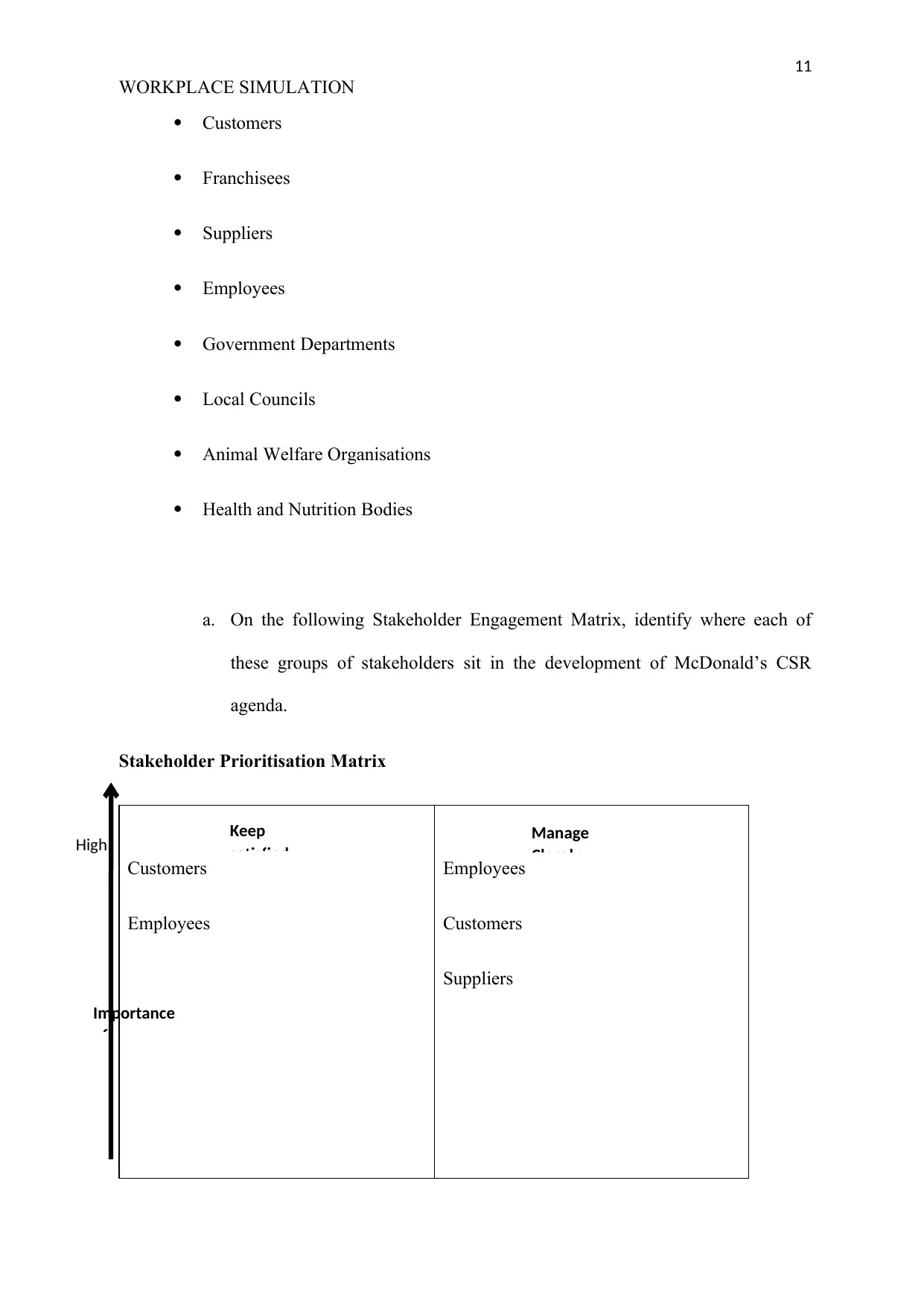
11
WORKPLACE SIMULATION
Customers
Franchisees
Suppliers
Employees
Government Departments
Local Councils
Animal Welfare Organisations
Health and Nutrition Bodies
a. On the following Stakeholder Engagement Matrix, identify where each of
these groups of stakeholders sit in the development of McDonald’s CSR
agenda.
Stakeholder Prioritisation Matrix
Customers
Employees
Employees
Customers
Suppliers
Importance
of
Keep
satisfied
Manage
Closely
High
WORKPLACE SIMULATION
Customers
Franchisees
Suppliers
Employees
Government Departments
Local Councils
Animal Welfare Organisations
Health and Nutrition Bodies
a. On the following Stakeholder Engagement Matrix, identify where each of
these groups of stakeholders sit in the development of McDonald’s CSR
agenda.
Stakeholder Prioritisation Matrix
Customers
Employees
Employees
Customers
Suppliers
Importance
of
Keep
satisfied
Manage
Closely
High
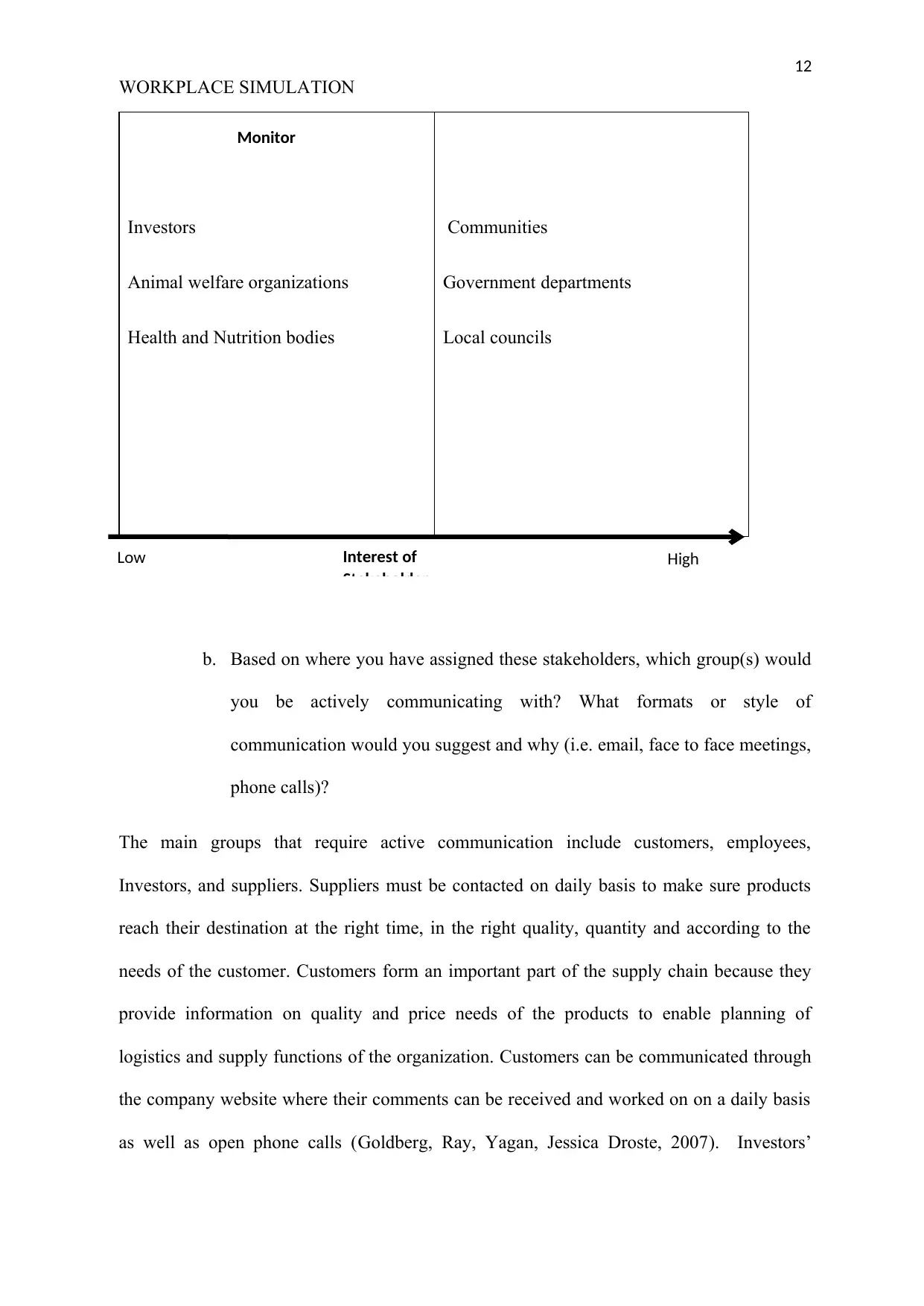
12
WORKPLACE SIMULATION
Investors
Animal welfare organizations
Health and Nutrition bodies
Communities
Government departments
Local councils
b. Based on where you have assigned these stakeholders, which group(s) would
you be actively communicating with? What formats or style of
communication would you suggest and why (i.e. email, face to face meetings,
phone calls)?
The main groups that require active communication include customers, employees,
Investors, and suppliers. Suppliers must be contacted on daily basis to make sure products
reach their destination at the right time, in the right quality, quantity and according to the
needs of the customer. Customers form an important part of the supply chain because they
provide information on quality and price needs of the products to enable planning of
logistics and supply functions of the organization. Customers can be communicated through
the company website where their comments can be received and worked on on a daily basis
as well as open phone calls (Goldberg, Ray, Yagan, Jessica Droste, 2007). Investors’
Interest of
Stakeholder
Monitor
Low High
WORKPLACE SIMULATION
Investors
Animal welfare organizations
Health and Nutrition bodies
Communities
Government departments
Local councils
b. Based on where you have assigned these stakeholders, which group(s) would
you be actively communicating with? What formats or style of
communication would you suggest and why (i.e. email, face to face meetings,
phone calls)?
The main groups that require active communication include customers, employees,
Investors, and suppliers. Suppliers must be contacted on daily basis to make sure products
reach their destination at the right time, in the right quality, quantity and according to the
needs of the customer. Customers form an important part of the supply chain because they
provide information on quality and price needs of the products to enable planning of
logistics and supply functions of the organization. Customers can be communicated through
the company website where their comments can be received and worked on on a daily basis
as well as open phone calls (Goldberg, Ray, Yagan, Jessica Droste, 2007). Investors’
Interest of
Stakeholder
Monitor
Low High
⊘ This is a preview!⊘
Do you want full access?
Subscribe today to unlock all pages.

Trusted by 1+ million students worldwide
1 out of 67
Related Documents
Your All-in-One AI-Powered Toolkit for Academic Success.
+13062052269
info@desklib.com
Available 24*7 on WhatsApp / Email
![[object Object]](/_next/static/media/star-bottom.7253800d.svg)
Unlock your academic potential
Copyright © 2020–2025 A2Z Services. All Rights Reserved. Developed and managed by ZUCOL.




